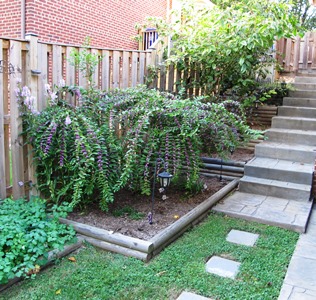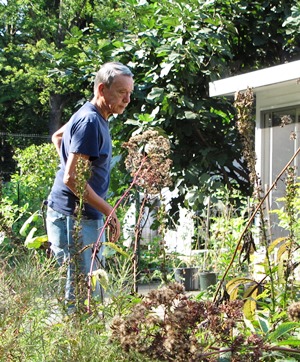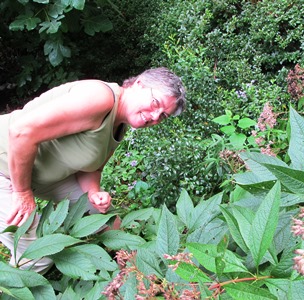Native plant gardens and rain barrels are a growing trend!
Neighbors who have already replaced some of their turf grass with native plant gardens can provide inspiration and ideas for your own garden. Learn more about homeowners in Montgomery County, Maryland, who have embraced native plant gardening with the help of the Izaak Walton League.
Elaine L.
 Elaine had a swamp in her back yard. The house was built into a slope, causing rain to run down into the back yard, where it pooled and sat after any storm. To rid her yard of these unwanted water features, Elaine used a combination of a rain garden, rain barrels, and a native plant garden (also called a “conservation landscape”) to improve water drainage around the house.
Elaine had a swamp in her back yard. The house was built into a slope, causing rain to run down into the back yard, where it pooled and sat after any storm. To rid her yard of these unwanted water features, Elaine used a combination of a rain garden, rain barrels, and a native plant garden (also called a “conservation landscape”) to improve water drainage around the house.
The first project she tackled was a rain garden in the front yard, which was part of a county-funded demonstration program. The garden is strategically placed by a downspout to absorb the water coming off the front side of the roof rather than letting it run into the yard. The rain garden is beautiful as well as functional. “When I’m out there gardening, I’ll have people stop by and say how much they like the garden and seeing how it changes over the seasons,” says Elaine.
She picked native plants and flowers both to attract wildlife and to provide year-round visual interest. With Joe Pye weed, a flowering herb, Elaine’s garden gets a lot of visits from goldfinches. Bumblebees (a native pollinator) are attracted to the “Obedient plant.” But there are also a few old friends in in her gardens. “You can keep your favorites, like roses or irises, and fill in around them with native plants – it doesn’t have to be all or nothing,” says Elaine. “You just want to put things together that have the same water requirements."
“Native grasses help for visual interest in the winter – it will brown up but still have the shape,” says Elaine. “Otherwise it will just be flat in the winter. The grasses help give it a little structure.” A ninebark shrub has interesting, peeling bark in the winter to add additional interest to the garden.
Elaine installed a rain barrel on the gutter downspout, which directs overflow water into the rain garden. “The first year, when the plants weren’t that big and the roots weren’t that deep, I had some ponding for a day in the garden. But the water soaks in really well now,” she says. Elaine rarely has to water the plants now that they are established. She uses water from the rain barrel for other planting beds in her yard.
On the other side of the house was a steep hill covered in invasive vines. During rain storms, Elaine says she had a waterfall going down the hill, which created a “lake” in the back yard. She pulled out all the vines and had a friend put in terraced planting beds. Then she selected native plants for each bed. Below the terraced bed, Elaine installed a second rain garden to absorb water from the back side of the roof.
Neighbors say Elaine’s garden is “the envy of the neighborhood – the gold standard.”
Perhaps that should be the “green standard.”
Jim F.
 Jim’s water problems extended beyond his yard. The home’s grassy back yard sloped slightly toward the house, and every time it rained, water from his gutters ran into the house. Jim’s solution: A rain garden.
Jim’s water problems extended beyond his yard. The home’s grassy back yard sloped slightly toward the house, and every time it rained, water from his gutters ran into the house. Jim’s solution: A rain garden.
He was familiar with the concept of a rain garden and knew that it could hold a lot of water. So he researched design plans online and grabbed a friend to help him with the project.
First they removed some decking and an unused hot tub – “hardscape” that was creating some of the runoff problem. Then they got to work on the soil, digging more than two feet down into packed clay and rock. “It was hard work shoveling that by hand,” Jim recalls. They filled the hole with a mixture of sand and soil, using the ratio recommended by the county. “At that time,” says Jim, “I didn’t know you could order this kind of soil to come premixed. So we mixed it ourselves using a rototiller."
Jim took an extra step to make sure his rain garden would hold all the water he needed it to hold. He put in “subdrains” – smaller holes dug down another 12-18 inches (a tulip bulb planter on the end of a hand drill did the job) and filled with pea gravel. These help water drain even better from the rain garden.
Was it worth the effort? “Absolutely,” says Jim. “It has prevented any water from getting into my house for 10 years!” And his yard still has plenty of open space for his grandsons to come over and play.
He also installed several rain barrels on the back side of the house. Most of them are used for drip irrigation for his vegetable gardens. Another sends rain runoff into a native plant garden. Jim says using collected rain to water his gardens has definitely lowered his water bill. And the grandkids love filling up a watering can from the barrels and watering the plants themselves.
Kit G.
 Montgomery County is famous for its stream valley parks, many of which are surrounded by suburban neighborhoods. One such public park is literally in Kit’s back yard – which is exactly why she and her husband bought the house 17 years ago. Since she moved in, Kit has slowly converted the yard from a collection of non-native plants and thin turf grass to a community of thriving native plants. She also installed a cistern (which has a larger capacity than a rain barrel) to help manage water on her property.
Montgomery County is famous for its stream valley parks, many of which are surrounded by suburban neighborhoods. One such public park is literally in Kit’s back yard – which is exactly why she and her husband bought the house 17 years ago. Since she moved in, Kit has slowly converted the yard from a collection of non-native plants and thin turf grass to a community of thriving native plants. She also installed a cistern (which has a larger capacity than a rain barrel) to help manage water on her property.
The back yard was originally filled with sickly grass and a few small plants, recalls Kit. The canopy of a large beech tree covers much of the back yard, and the grass underneath “looked terrible.” Despite the deep shade, however, the previous homeowners kept trying to grow grass there.
“It’s hard to grow plants in shade,” says Kit. “However, a lot of the plants that are available to plant in shade are native. The things that tend to grow in shade are more durable, tend to be less flowery.” Kit gradually replaced the turf grass under the tree canopy with native plants – and then moved on to other areas of the yard. She has a rain garden and pond in the back yard and multiple areas with native plants in the front yard, some in shade and some in full sun.
Taking care of her native plants requires occasionally yanking out a vine or weed, but that’s about it. “Natives tend to do better, especially if you’re not fertilizing them and using pesticides – they don’t need it because they grew up here,” she explains.” If you want relative ease of maintenance, natives are more likely to work.”
What’s her favorite thing about her yard now? “Part of it is to see what comes up, because there are surprises,” says Kit. “The seasonal variability of the flowers. Such variety of birds and butterflies and other animals that come through here. They take what they need. The birds eat the bugs. Some bugs eat other bugs. So you’ve got more of a balance than you would have if you sprayed it with pesticides.”
There is also plenty of room for children to play. “My grand-nieces climbed trees, hid in the plants. They’ve been having a great adventure here. I also have a granddaughter. We bring her here and sit her on the lawn. I don’t use fertilizer or pesticides, so I’m not at all worried to have a 10-month-old sitting in the grass. I know that all she’s going to be eating is grass! As she grows up, she’s going to be crawling on it and rolling balls on it.” And perhaps following in her grandmother’s “green footprint.”
See conservation landscaping in action with our three-minute video.